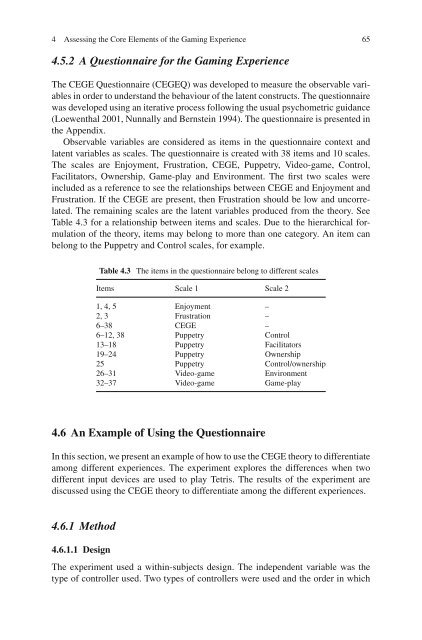Evaluating User Experience in Games: Concepts and Methods - Lirmm
Evaluating User Experience in Games: Concepts and Methods - Lirmm
Evaluating User Experience in Games: Concepts and Methods - Lirmm
You also want an ePaper? Increase the reach of your titles
YUMPU automatically turns print PDFs into web optimized ePapers that Google loves.
4 Assess<strong>in</strong>g the Core Elements of the Gam<strong>in</strong>g <strong>Experience</strong> 65<br />
4.5.2 A Questionnaire for the Gam<strong>in</strong>g <strong>Experience</strong><br />
The CEGE Questionnaire (CEGEQ) was developed to measure the observable variables<br />
<strong>in</strong> order to underst<strong>and</strong> the behaviour of the latent constructs. The questionnaire<br />
was developed us<strong>in</strong>g an iterative process follow<strong>in</strong>g the usual psychometric guidance<br />
(Loewenthal 2001, Nunnally <strong>and</strong> Bernste<strong>in</strong> 1994). The questionnaire is presented <strong>in</strong><br />
the Appendix.<br />
Observable variables are considered as items <strong>in</strong> the questionnaire context <strong>and</strong><br />
latent variables as scales. The questionnaire is created with 38 items <strong>and</strong> 10 scales.<br />
The scales are Enjoyment, Frustration, CEGE, Puppetry, Video-game, Control,<br />
Facilitators, Ownership, Game-play <strong>and</strong> Environment. The first two scales were<br />
<strong>in</strong>cluded as a reference to see the relationships between CEGE <strong>and</strong> Enjoyment <strong>and</strong><br />
Frustration. If the CEGE are present, then Frustration should be low <strong>and</strong> uncorrelated.<br />
The rema<strong>in</strong><strong>in</strong>g scales are the latent variables produced from the theory. See<br />
Table 4.3 for a relationship between items <strong>and</strong> scales. Due to the hierarchical formulation<br />
of the theory, items may belong to more than one category. An item can<br />
belong to the Puppetry <strong>and</strong> Control scales, for example.<br />
Table 4.3 The items <strong>in</strong> the questionnaire belong to different scales<br />
Items Scale 1 Scale 2<br />
1, 4, 5 Enjoyment –<br />
2, 3 Frustration –<br />
6–38 CEGE –<br />
6–12, 38 Puppetry Control<br />
13–18 Puppetry Facilitators<br />
19–24 Puppetry Ownership<br />
25 Puppetry Control/ownership<br />
26–31 Video-game Environment<br />
32–37 Video-game Game-play<br />
4.6 An Example of Us<strong>in</strong>g the Questionnaire<br />
In this section, we present an example of how to use the CEGE theory to differentiate<br />
among different experiences. The experiment explores the differences when two<br />
different <strong>in</strong>put devices are used to play Tetris. The results of the experiment are<br />
discussed us<strong>in</strong>g the CEGE theory to differentiate among the different experiences.<br />
4.6.1 Method<br />
4.6.1.1 Design<br />
The experiment used a with<strong>in</strong>-subjects design. The <strong>in</strong>dependent variable was the<br />
type of controller used. Two types of controllers were used <strong>and</strong> the order <strong>in</strong> which

















